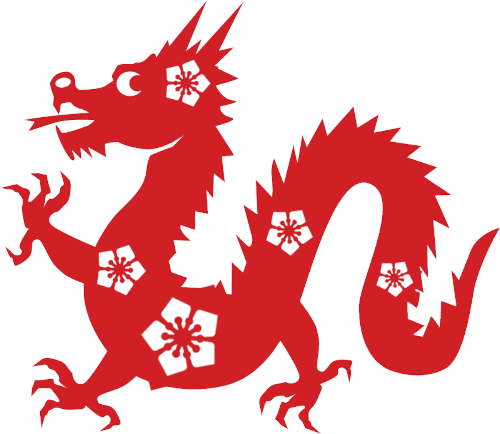Dear Iaido Friends,
we love to draw inspiration from japanese metaphysics, including the Chinese calendar. Looking back at the past Yin year, designated as the ›Water-Rabbit‹, we recall the characteristic calm qualities associated with this year. New experiences are eagerly embraced and evolve on a spiritual level. Water-Rabbits possess an excellent sense of empathy, enjoy communication with others, and exhibit intuition. The training year reflected productive and positive exchanges within the group, with an intuitive approach to solving kata tasks. Particularly we gratify our newcomers, who, with their openness, give us enriching questions.
Soon, the Chinese Year of the ›Wood-Dragon‹, influenced by Wood /*. Wood represents growth, expansion, and creativity—qualities associated with Yang energy—active, dynamic, and outward-oriented. This year presents also an opportunity to draw inspiration from the symbolism of the Dragon. Dragons are considered self-confident, intelligent, and full of energy. In our Iaido training, we can harness these qualities by confidently developing our skills, intelligently refining our techniques, and feeling the Dragon’s energy in our posture and execution.
Go for a a year full of growth, success, and collective strength! May the Year of the Wood-Dragon bring good luck to you all.
The Dojo Leadership.
About the Elemental Theory
The Elemental Approach in Chinese martial arts is based on
five elements – 木 (Wood), 火 (Fire), 土 (Earth), 金 (Metal), and 水 (Water) -, each associated with specific characteristics. This is really practical. One can learn from it to understand principles of movement, attack, and defense in Iaido.
- Mu (木): Wood. In Chinese martial arts, Wood represents growth and expansion. Movements are often linear, upward, and energetic.
- Huo (火): Fire. Fire signifies energy, dynamism, and speed. Techniques can be fast, impulsive, and powerful.
- Tu (土): Earth. Earth symbolizes stability and balance. Fight techniques focus on stability, equilibrium, and grounding.
- Jin (金): Metal. Metal is associated with precision and clarity. Movements are often sharp, direct, and efficient.
- Shui (水): Water. Water represents flexibility and adaptability. Martial art movements can be flowing, circular, and smooth.
Integrating the Elemental Approach into martial arts allows practitioners to not only learn physical techniques but also to develop a deeper understanding of energy principles and holistic health. This approach emphasizes the connection of body, mind, and energy within the context of martial arts practice.
In Japan, martial arts often incorporate the more philosophical concept of ›Gogyō‹ or the ›Five Elements‹, originally derived from Chinese philosophy (see above). The five elements in the Japanese version are:
- Chi (地): Earth. Chi represents Earth or ground. It symbolizes stability, steadfastness, and the foundation.
- Sui (水): Water. The element of Water signifies fluidity, adaptability, and flexibility. It can also be associated with a clear, reflective nature.
- Ka (火): Fire. Ka stands for the element of Fire, embodying energy, dynamism, and determination. Fire also symbolizes the passion and determination of the practitioner.
- Fu (風): Wind/Air. Wind or Air stands for agility, speed, and the principle of unpredictability. It also represents the art of adaptation.
- Kū (空): Void/Space. The element Void or Ku represents space, emptiness, or the absence of form. It symbolizes the principle of openness, mental clarity, and the ability to absorb everything.
